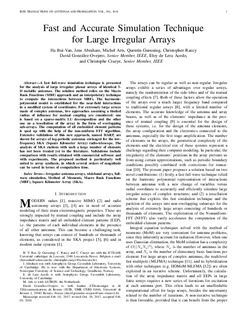| dc.contributor.author | Bui Van, Ha | |
| dc.contributor.author | Abraham, Jens | |
| dc.contributor.author | Arts, Michel | |
| dc.contributor.author | Gueuning, Quentin | |
| dc.contributor.author | Raucy, Christopher | |
| dc.contributor.author | González-Ovejero, David | |
| dc.contributor.author | de Lera Acedo, Eloy | |
| dc.contributor.author | Craeye, Christophe | |
| dc.date.accessioned | 2019-01-03T08:55:27Z | |
| dc.date.available | 2019-01-03T08:55:27Z | |
| dc.date.created | 2018-04-09T11:22:21Z | |
| dc.date.issued | 2018 | |
| dc.identifier.citation | IEEE Transactions on Antennas and Propagation. 2018, 66 (4), 1805-1817. | nb_NO |
| dc.identifier.issn | 0018-926X | |
| dc.identifier.uri | http://hdl.handle.net/11250/2578874 | |
| dc.description.abstract | A fast full-wave simulation technique is presented for the analysis of large irregular planar arrays of identical 3-D metallic antennas. The solution method relies on the macro basis function (MBF) approach and an interpolatory technique to compute the interactions between MBFs. The harmonicpolynomial model is established for the near-field interactions in a modified system of coordinates. For extremely large arrays made of complex antennas, two approaches assuming a limited radius of influence for mutual coupling are considered: one is based on a sparse matrix LU-decomposition and the other one on a tessellation of the array in the form of overlapping subarrays. The computation of all embedded element patterns is sped up with the help of the nonuniform fast Fourier transform algorithm. Extensive validations of this new approach, named HARP, are shown for arrays of log-periodic antennas envisaged for the lowfrequency Square Kilometer Array (SKA) radio telescope. The analysis of SKA stations with such a large number of elements has not been treated yet in the literature. Validations include comparison with results obtained with commercial software and with experiments. The proposed method is particularly well suited to array synthesis, in which several orders of magnitude can be saved in terms of computation time. | nb_NO |
| dc.language.iso | eng | nb_NO |
| dc.publisher | Institute of Electrical and Electronics Engineers (IEEE) | nb_NO |
| dc.title | Fast and Accurate Simulation Technique for Large Irregular Arrays | nb_NO |
| dc.type | Journal article | nb_NO |
| dc.type | Peer reviewed | nb_NO |
| dc.description.version | acceptedVersion | nb_NO |
| dc.source.pagenumber | 1805-1817 | nb_NO |
| dc.source.volume | 66 | nb_NO |
| dc.source.journal | IEEE Transactions on Antennas and Propagation | nb_NO |
| dc.source.issue | 4 | nb_NO |
| dc.identifier.doi | 10.1109/TAP.2018.2806222 | |
| dc.identifier.cristin | 1578301 | |
| dc.description.localcode | © 2018 IEEE. Personal use of this material is permitted. Permission from IEEE must be obtained for all other uses, in any current or future media, including reprinting/republishing this material for advertising or promotional purposes, creating new collective works, for resale or redistribution to servers or lists, or reuse of any copyrighted component of this work in other works. | nb_NO |
| cristin.unitcode | 194,63,35,0 | |
| cristin.unitname | Institutt for elektroniske systemer | |
| cristin.ispublished | true | |
| cristin.fulltext | postprint | |
| cristin.qualitycode | 1 | |
